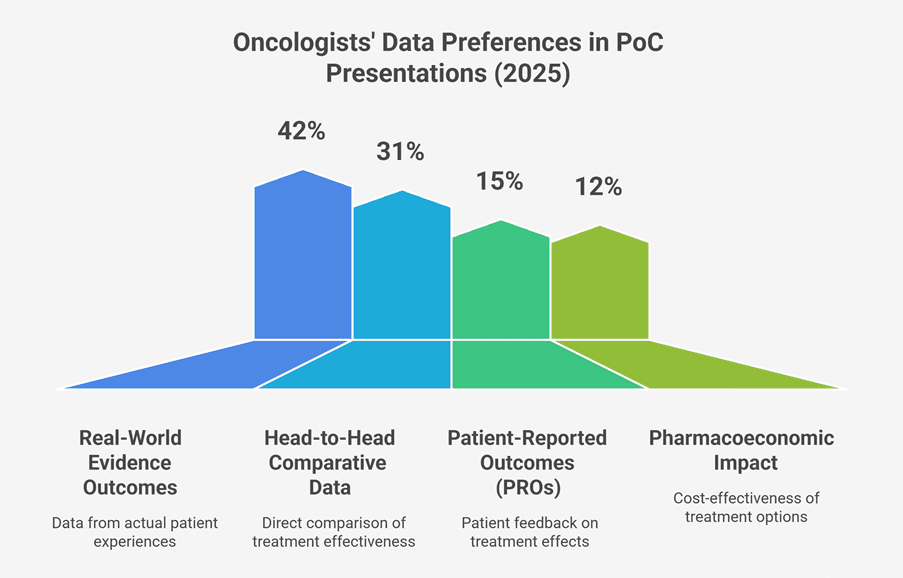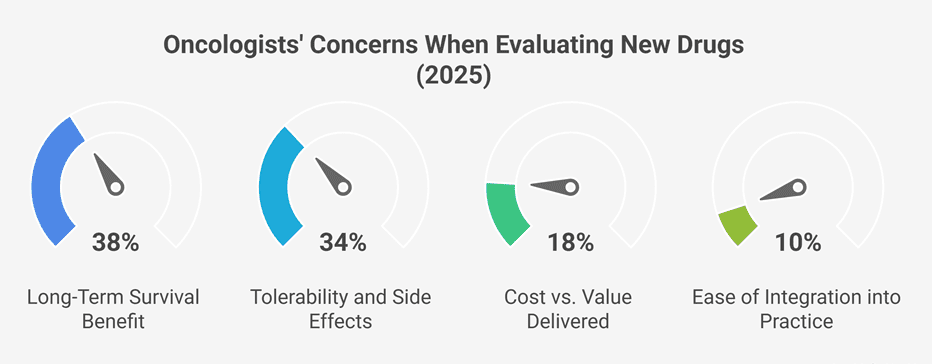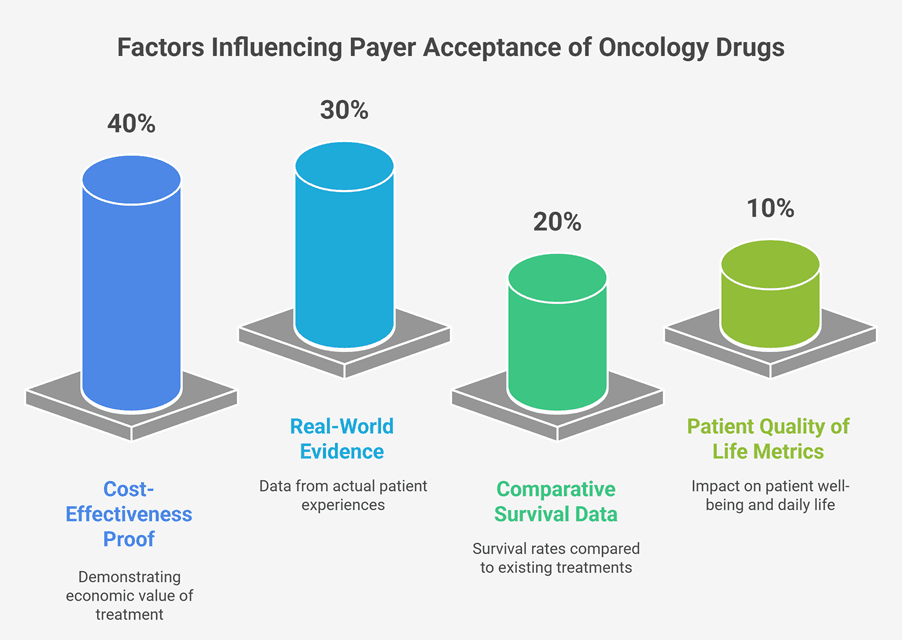Introduction: A Shift from Promotion to Proof
In oncology marketing, claims no longer carry weight unless backed by real-world evidence. Oncologists, already overwhelmed by clinical data, need clarity, proof, and contextual insights rather than glossy brochures or sales pitches. This is where AI-driven proof of concept (PoC) strategies are transforming pharma marketing, shifting the conversation from “here’s what our drug can do” to “here’s the evidence of how it performs in patients like yours.”
Instead of merely telling oncologists about efficacy, AI allows pharma companies to show real-time, context-specific data, simulated outcomes, and validated case studies. The marketing function is evolving into a knowledge partner role, helping oncologists visualize value through AI-powered analytics, predictive modeling, and immersive digital tools.
This article explores how pharma can leverage AI-driven PoCs to create trust, shorten adoption cycles, and differentiate in the crowded oncology space.
1. From Promotion to Proof-First Engagement
Traditional detailing emphasized messaging. AI shifts the lens to evidence-first communication. By integrating trial data, real-world evidence, and patient outcomes, oncologists are not just hearing about a drug, they’re seeing its performance mapped to their patient population.
- AI creates comparative dashboards versus standard of care.
- Risk-benefit visualization tools help oncologists validate decision-making.
- Treatment journey projections show expected progression-free survival or toxicity risks.
2. Contextualized Insights for Each Oncologist
AI allows marketers to tailor PoCs per oncologist profile:
- Academic oncologists: deep molecular evidence and journal references.
- Community oncologists: simplified real-world data and case-based outcomes.
- Surgeons or radiotherapists: integration of multi-modality data to show synergy.
This personalized data framing ensures that PoCs resonate with each practitioner’s priorities.
3. Digital Twins as Proof Engines
AI can create digital twins of cancer patients based on genetic, clinical, and behavioral data. Pharma marketers can then simulate drug performance on these twins:
- Predict likelihood of response.
- Demonstrate side-effect probabilities.
- Compare twin outcomes under different therapies.
This is not hypothetical, it is an AI-powered proof, making the drug’s value tangible.
4. Real-World Evidence (RWE) as Marketing Fuel
AI sifts through electronic health records (EHRs), registries, and post-marketing surveillance to generate RWE dashboards. Instead of general claims, oncologists see:
- Local hospital outcomes with the drug.
- Survival benefits in demographically similar patients.
- Real-world adherence and discontinuation rates.
This evidence-based storytelling builds stronger credibility.
5. The Power of Comparative Visuals
When oncologists are presented with head-to-head comparisons, adoption improves. AI enables real-time comparisons of a drug against competitors:
- Kaplan-Meier survival curves auto-generated.
- Side-effect frequencies plotted visually.
- Cost-effectiveness maps for payer-linked decision-making.

6. Reducing Cognitive Overload with AI Summaries
Oncologists are time-starved. AI-driven summarization engines can distill hundreds of pages of trial data into:
- A one-page PoC dashboard.
- Key efficacy endpoints vs. standard of care.
- Side-effect alerts customized to the oncologist’s practice type.
This simplifies decision-making without compromising scientific rigor.
7. Personalizing Risk-Benefit Tradeoffs
Every oncologist weighs risk differently. AI can model:
- Probability of Grade 3+ toxicities.
- Time-to-event endpoints (OS, PFS).
- Likelihood of treatment discontinuation.
Oncologists’ Primary Concerns When Evaluating a New Drug (2025)
- Long-Term Survival Benefit – 38%
- Tolerability and Side Effects – 34%
- Cost vs. Value Delivered – 18%
- Ease of Integration into Practice – 10%

8. Showing Proof at the Point of Care
AI-powered tablets or apps can demonstrate value during consultations. For instance:
- Oncologist inputs patient data.
- AI generates personalized outcome projections with the new therapy.
- The oncologist sees proof in real-time, enabling more confident prescribing.
9. Clinical Trial Transparency as Trust Currency
Pharma can use AI to unlock trial-level transparency:
- Subgroup analysis on underrepresented populations.
- Outcomes segmented by comorbidities.
- Visualization of trial dropouts and reasons.
Such radical transparency fosters oncologist trust and differentiates a brand.
10. PROs and QoL as Proof of Value
Beyond survival, quality of life (QoL) is critical. AI integrates patient-reported outcomes (PROs) such as fatigue reduction, emotional well-being, and daily function into PoCs, transforming intangible experiences into measurable metrics.
11. Predictive Modeling for Patient Fit
Pharma reps can use AI PoCs to help oncologists identify ideal patient candidates:
- Which biomarkers predict the best response.
- Which comorbidities may contraindicate use.
- Expected adherence challenges by demographic.
This makes PoCs highly actionable.
12. Localized Proof for Local Trust
Instead of global averages, AI can extract regional outcome data:
- Lung cancer survival in Indian metros.
- Breast cancer recurrence rates in rural populations.
- Oral cancer outcomes in tobacco-heavy districts.
This “local proof” resonates more than global trial results.
13. Ethical Guardrails in AI Proof
Pharma must ensure that PoCs remain ethical:
- Transparent AI methodologies.
- No overstatement of results.
- Disclosure of data limitations.
Trust is sustained when proof is honest, not exaggerated.
14. Multi-Modal Data Integration
AI integrates imaging, genomics, and clinical data into holistic PoCs:
- Radiology scans over time showing tumor shrinkage.
- Genomic heatmaps of mutational response.
- Clinical outcome overlays.
This multi-modal view proves value across the care continuum.
15. Proving Cost-Effectiveness with AI
In oncology, the value of a therapy is judged not only by survival outcomes but also by its affordability within healthcare systems. AI provides pharma with powerful tools to demonstrate cost-effectiveness in ways payers trust.
AI-driven models calculate:
- Incremental Cost-Effectiveness Ratios (ICERs) – allowing comparisons between new drugs and standard of care.
- Quality-Adjusted Life Years (QALYs) – highlighting the balance between extended survival and quality of life improvements.
- Hospitalization avoidance metrics – showcasing cost savings from fewer complications and emergency admissions.
Such analyses reassure payers and policymakers that new therapies provide sustainable value.

16. Interactive Proof Platforms for Oncologists
Static brochures or PDFs no longer satisfy oncologists who want hands-on control over data. Pharma can now deploy AI-powered, interactive proof platforms that give clinicians freedom to explore and validate insights on their own terms.
On these platforms, oncologists can:
- Dive into datasets independently – filtering results by tumor type, stage, or biomarker status.
- Run “what-if” simulations – projecting how different patient characteristics may influence outcomes.
- Download AI-curated case summaries – ready-to-use evidence packages for tumor board discussions.
By shifting from passive content delivery to interactive engagement, pharma transforms oncologists from information recipients into evidence explorers, increasing both trust and adoption.
17. AI as a Myth-Busting Engine of Proof
Misinformation in oncology spreads quickly, often through unverified online forums or misinterpretations of data. AI-powered PoCs act as real-time myth-busting engines, helping pharma counter false narratives with credibility.
AI enables pharma to:
- Dispel exaggerated side-effect fears with validated toxicity data.
- Correct trial misinterpretations by presenting accurate subgroup analyses.
- Reinforce genuine benefits while filtering out unscientific claims or hearsay.
By positioning themselves as the source of verified truth, pharma brands can combat skepticism, build oncologist confidence, and strengthen patient trust.
18. Accelerating the Adoption Curve
In oncology, the path from clinical approval to mainstream adoption is often long and uneven. Many promising drugs take years before they become embedded in treatment protocols. AI-powered Proof of Concept (PoC) models are transforming this trajectory by reducing the barriers that slow acceptance.
AI-driven PoCs help by:
- Translating trial data into actionable insights – Instead of dense statistical reports, AI generates intuitive dashboards that oncologists can quickly interpret. Endpoints like progression-free survival or response rates are contextualized against familiar cases.
- Clarifying patient selection – Advanced algorithms highlight which subgroups benefit most, reducing hesitation and avoiding inappropriate prescribing.
- Providing localized validation early – By integrating real-world outcomes from regional hospitals, AI gives oncologists confidence that the drug works in patients similar to their own.
This approach shifts adoption from being reactive and slow to proactive and evidence-led, ensuring that therapies reach patients faster without compromising safety.
19. Pharma Reps as AI-Powered Proof Guides
The traditional role of pharma representatives as mere product messengers is fading. In the AI-driven proof-first era, they are becoming navigators of evidence ecosystems. Their value lies in their ability to guide oncologists through sophisticated PoC platforms.
Their responsibilities now include:
- Demonstrating navigation of PoC dashboards – Reps showcase interactive data tools instead of static brochures, allowing oncologists to experiment with scenarios.
- Interpreting personalized outputs – By explaining AI-generated projections tailored to an oncologist’s patient base, reps ensure clarity and trust.
- Acting as data concierges – Rather than pushing messages, they curate, filter, and contextualize insights that matter most to each practice.
This transformation positions pharma reps not as sellers, but as partners in clinical decision-making, which strengthens long-term brand credibility.
20. Enriching Multidisciplinary Tumor Boards
Treatment decisions in oncology are rarely made in isolation. Tumor boards, where oncologists, radiologists, surgeons, and pathologists collaborate, play a decisive role. Embedding AI-driven PoCs into these discussions elevates the quality of evidence considered.
AI contributions include:
- Real-time drug response simulations – Predictive models show how different patients might respond, adding depth to clinical deliberations.
- Comparative analysis of therapy options – Oncologists can weigh efficacy, toxicity, and cost-effectiveness side by side.
- Evidence-backed recommendations – AI synthesizes trial and real-world data, ensuring decisions are rooted in proof, not opinion.
By offering a shared evidence canvas, AI PoCs make tumor boards more data-rich and collaborative, ultimately benefiting patient care.
21. Refining Proof Narratives with Sentiment Analysis
Even the strongest data can fail if its presentation doesn’t resonate. AI’s sentiment analysis capabilities allow pharma teams to continuously adapt PoC narratives to oncologists’ perceptions and concerns.
Feedback-driven refinements include:
- Simplifying visuals when overwhelmed – Dense graphs are replaced with clearer, patient-centric visuals.
- Adding transparency when skepticism rises – Detailed methodology and assumptions are shared to build credibility.
- Integrating stories when engagement is low – Real case examples humanize the data and create emotional resonance.
This dynamic adjustment loop ensures that PoC storytelling evolves in response to audience sentiment, keeping it authentic, relevant, and trusted.
22. Patient-Centered Proof as an Indirect Driver
Pharma has traditionally focused its evidence narrative on clinicians, but patients now play an indirect yet powerful role in drug adoption. AI-powered PoCs extend proof beyond medical circles, empowering patients to understand value in relatable terms.
Key tools include:
- AI apps that project survival timelines – Communicated in patient-friendly language, helping patients grasp benefits.
- Dashboards showcasing quality-of-life improvements – Sleep, fatigue, and daily activity measures are highlighted.
- Survivor testimonials linked with data – Peer stories backed by hard evidence build both hope and credibility.
When patients recognize proof and voice preferences, oncologists feel supported in prescribing. This creates bottom-up demand, complementing traditional top-down education.
23. Scaling Proof Across Diverse Geographies
Global pharma brands must balance consistency with localization. AI platforms make this possible by creating scalable yet adaptable PoCs.
Scalable strategies include:
- Language translation for inclusivity – Data dashboards are instantly available in local languages, breaking communication barriers.
- Regional epidemiology integration – PoCs reflect local cancer prevalence, making insights highly relevant.
- Country-specific pricing models – AI demonstrates cost-effectiveness within each market’s reimbursement framework.
This dual ability to scale globally while staying locally resonant ensures that proof speaks to oncologists in every geography, no matter how diverse.
24. Future Outlook: Proof as the New Language of Trust
The oncology landscape is moving toward a proof-first paradigm where claims unsupported by evidence will no longer find acceptance. AI-powered PoC ecosystems are set to become the standard, not the exception.
Looking forward:
- Proof of concept will no longer be confined to pre-launch, it will continuously evolve post-market as real-world data accumulates.
- Engagement with oncologists will be rooted in interactive evidence-sharing, not one-way messaging.
- Trust will be earned not through persuasion, but through transparent, contextualized, and actionable proof.
The future of oncology marketing belongs to brands that replace promises with proof in practice. By embedding AI into every stage of engagement, pharma companies can accelerate adoption, improve credibility, and most importantly, ensure that patients benefit from cutting-edge therapies sooner.
Conclusion
The age of telling oncologists about a drug’s promise is ending. The future belongs to brands that can show proof, personalized, contextualized, and validated through AI.
By leveraging digital twins, real-world evidence, predictive modeling, and interactive dashboards, pharma companies can transform oncology marketing from persuasion into partnership.
Oncologists gain not just claims but confidence. Patients benefit from timely, well-informed treatment. And pharma earns the most valuable currency in oncology: trust built on proof.
The Oncodoc team is a group of passionate healthcare and marketing professionals dedicated to delivering accurate, engaging, and impactful content. With expertise across medical research, digital strategy, and clinical communication, the team focuses on empowering healthcare professionals and patients alike. Through evidence-based insights and innovative storytelling, Hidoc aims to bridge the gap between medicine and digital engagement, promoting wellness and informed decision-making.



